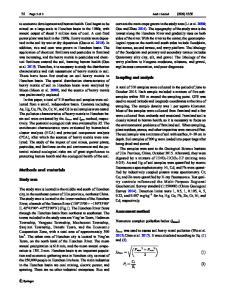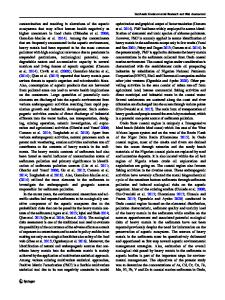Potential Ecological Risk of Heavy Metals in a Typical Tributary of the Three Gorges Reservoir
- PDF / 1,273,612 Bytes
- 6 Pages / 595.276 x 790.866 pts Page_size
- 59 Downloads / 312 Views
Potential Ecological Risk of Heavy Metals in a Typical Tributary of the Three Gorges Reservoir Zhiqing Fang1,2 · Yongmin Wang1 · Deti Xie1 · Dingyong Wang1 Received: 5 July 2020 / Accepted: 28 September 2020 © Springer Science+Business Media, LLC, part of Springer Nature 2020
Abstract Water and sediment samples were collected from a tributary (Ruxi River) of the Three Gorges Reservoir (TGR) to analyze the concentrations of seven heavy metals (HMs) and their fractions for better understanding the migration, bioavailability and potential environmental risk of HMs. The results indicated that the concentrations of HMs in water were lower than the Environmental Quality Standards for Surface Water Class I standards, except for Ni. Cd in sediment was found to be more sensitive to environmental changes, as the acid-soluble fraction of Cd accounted for about 40% of total Cd, and the sediment–water partition coefficient of Cd was the smallest among all the HMs. Meanwhile, multiple risk assessment methods of HMs indicated that sediment Cd in most sampling sites, significantly influenced by human activities, exhibited heavy pollution, suggesting that the Cd pollution should be attached great importance in the Ruxi River. Keywords Ruxi River · Heavy metals · Sediment · Ecological risk Heavy metals (HMs), originating from natural and anthropogenic sources, were prevalent and persistent in the environment. HMs have been regarded as serious global pollutants due to their toxicity, non-biodegradable nature and biological enrichment by food chain in aquatic environment (Liu et al. 2016; Yang et al. 2019). Following the discharge of HMs into water bodies, they could precipitate and accumulate in the sediment eventually (Fang et al. 2019; Hwang et al. 2019), making the sediment a sink of HMs. Whereas, sediment could become a pollution source by releasing HMs into overlying water when encountering water disturbance ( Zhao et al. 2018; Deng et al. 2020). The Three Gorges Reservoir (TGR), with an area of 1084 km2, is the largest reservoir in China. Along the 650 kmlong main stream (Yangze River), there are more than 40 Electronic supplementary material The online version of this article (https://doi.org/10.1007/s00128-020-03014-5) contains supplementary material, which is available to authorized users. * Dingyong Wang [email protected] 1
College of Resources and Environment, Southwest University, Chongqing 400715, People’s Republic of China
College of Ecological Environmental Engineering, Guizhou Minzu University, Guiyang 550025, People’s Republic of China
2
tributaries with a basin area over 100 km2 (Gao et al. 2017; Niu et al. 2019; Lin et al. 2020). The main stream water could flow backwards into the tributary with the water level increase of the TGR, whereas the tributary water would flow into the Yangtze River with the adjustment of water level. The backwater zones are thus formed with the water level management of the TGR. However, it is noted that the hydrodynamic conditions of the tributary could be changed with
Data Loading...











